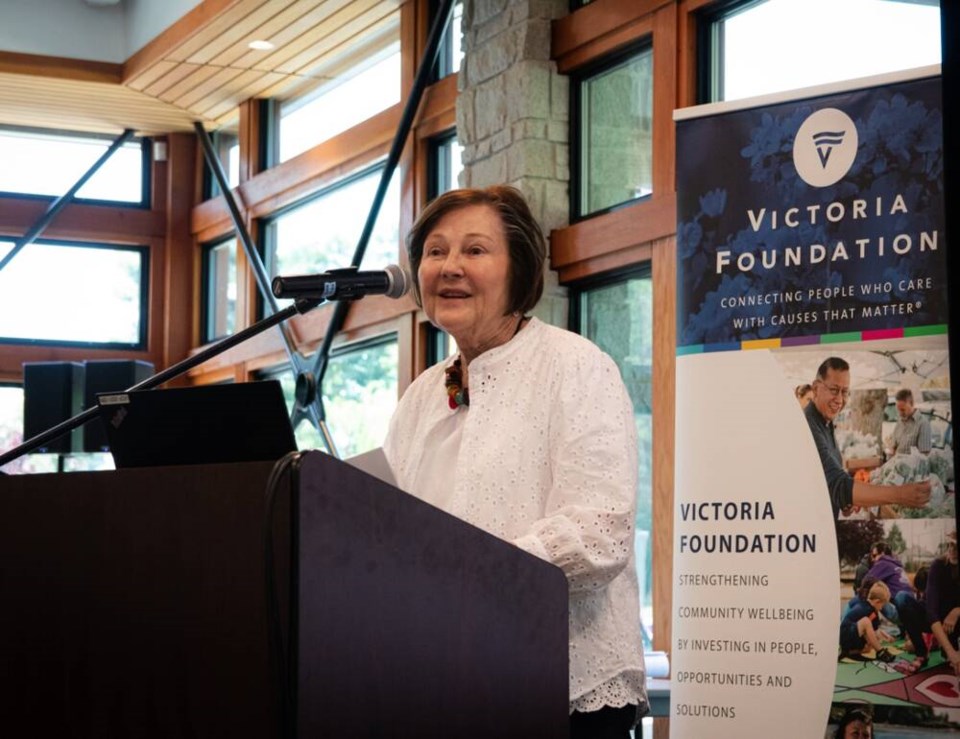Art can expose levels of meaning that can change our perspectives.

On a recent walk down the Songhees Walkway, I had the privilege of watching a group of Indigenous paddlers in a dozen beautifully crafted canoes make their journey to the Inner Harbour, where they were received at this year’s National Guardians Gathering. I was reminded of how deep the history and cultures of this Lekwungen-speaking region goes.
This June, National Indigenous History Month, I’m reflecting on our region’s original inhabitants with gratitude and admiration, and on the importance of celebrating art and traditions that have forged centuries of rich identities and ways to understand the world.
For me, artwork can tell the stories of our homes and communities with a uniquely creative voice. It can expose new levels of meaning that make deep impressions and can change our perspectives.
Exploring reconciliation through art can be a profound experience. At our recent annual donor appreciation event, we had the pleasure of listening to Marion Newman’s performance of Ancestral Voices. Marion grew up in Sooke and is an accomplished opera singer of the Kwagiulth and Stó:lō Nations. Her performances are challenging the definition of “Canadian music,” and are a force for reconciliation in the classical arts.
Her brother, Carey Newman, is an artist and master carver, known in part for creating the Witness Blanket — a national installation on the story of residential schools. It features hundreds of items salvaged from schools, churches and other cultural sites, and is now on display at the Canadian Museum for Human Rights in Winnipeg.
The foundation relies on Indigenous knowledge and leadership. Carey is a former board member of the Victoria Foundation, and I’m grateful that such a skilled storyteller brought his critical perspectives to the foundation’s decision making.
I greatly appreciate our past board chair Patrick Kelly, of the Leq’a:mel Nation, who continues to provide his expertise as our Indigenous cultural advisor.
Our current board chair, Tamara Napoleon, of the Saulteau First Nations, is an invaluable leader. At the donor appreciation event, she spoke of how the foundation is working to support organizations in their reconciliation initiatives, including its support for establishing Canada’s first Indigenous law school at the University of Victoria.
Tamara also spoke of the foundation’s support for creating the Indigenous-led granting advisory pilot. This critical program, led by an all-Indigenous advisory, makes granting decisions that better reflect local values and priorities. The funding is made possible by the generosity of our community.
Among many initiatives, this program supports organizations like PEPAKEṈ HÁUTW̱, a plant nursery leading important native ecosystem restoration projects, and VIDEA, a non-profit in Fernwood using art to bring healing to two-spirited individuals through colourful variations on traditional regalia.
Also, the Pauquachin Nation’s marine team has been working tirelessly to restore the clam harvest on Coles Bay beach in their territory, after it was closed due to marine pollution nearly 30 years ago.
You can read about these tremendous initiatives, and many others supported by our community, in our upcoming edition of Pulse magazine. Pulse is a response to our annual Vital Signs report, spotlighting wonderful organizations that boost all areas of our region’s vitality, from the environment to the arts, housing, reconciliation and more.
I encourage you to open a copy online or in print on July 8.
>>> To comment on this article, write a letter to the editor:[email protected]